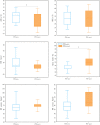Phrenic nerve stimulation for the treatment of central sleep apnea in patients with heart failure
- PMID: 35978055
- PMCID: PMC10227108
- DOI: 10.1007/s11325-022-02699-8
Phrenic nerve stimulation for the treatment of central sleep apnea in patients with heart failure
Abstract
Objective: Central sleep apnea (CSA) is associated with increased morbidity and mortality in patients with heart failure (HF). We aimed to explore the effectiveness of phrenic nerve stimulation (PNS) on CSA in patients with HF.
Methods: This was a prospective and non-randomized study. The stimulation lead was inserted into the right brachiocephalic vein and attached to a proprietary neurostimulator. Monitoring was conducted during the implantation process, and all individuals underwent two-night polysomnography.
Results: A total of nine subjects with HF and CSA were enrolled in our center. There was a significant decrease in the apnea-hypopnea index (41 ± 18 vs 29 ± 25, p = 0.02) and an increase in mean arterial oxygen saturation (SaO2) (93% ± 1% vs 95% ± 2%, p = 0.03) after PNS treatment. We did not observe any significant differences of oxygen desaturation index (ODI) and SaO2 < 90% (T90) following PNS. Unilateral phrenic nerve stimulation might also categorically improve the severity of sleep apnea.
Conclusion: In our non-randomized study, PNS may serve as a therapeutic approach for CSA in patients with HF.
Keywords: Central sleep apnea; Heart failure; Phrenic nerve stimulation.
© 2022. The Author(s).
Conflict of interest statement
The authors declare no competing interests.
Figures
References
MeSH terms
LinkOut - more resources
Full Text Sources
Medical
Research Materials
Miscellaneous



